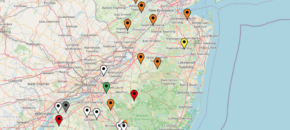Peach: Oriental Fruit Moth: A biofix point for OFM was set on 4/10 in both northern and southern counties. All Treatments OFM this season have past. Monitor traps and treat for counts over 6 adult moths/trap. OFM 2nd Generation Timing Insecticide Type County/Region Degree Days by 7/24 base 45 Conventional 2100-2200 2450-2500 Intrepid/Rimon 2000-2100 2350-2450 […]
Continue reading...Pre-Harvest Water Requirements Under the Produce Safety Rule
Note: The following is a brief description of the pre-harvest water requirements (Section 112.3-112.161) under the Food Safety Modernization Act/Produce Safety Rule (FSMA/PSR). The pre-harvest water requirements are complicated and this summary is intended to be a starting point while we wait for guidance from the Food and Drug Administration (FDA). For those who have […]
Continue reading...UPDATE – Box tree moth confirmed at private residence in Kent County DE. BE ON THE LOOKOUT

UPDATE: Box Tree Moth has been positively confirmed in Kent County – DE. PLEASE BE VIGILANT Click here to see the original link from DE.gov (write-up with more photos) “The United States Department of Agriculture’s Animal and Plant Health Inspection Service (USDA-APHIS) has confirmed a find of box tree moth (BTM; Cydalima perspectalis) at a […]
Continue reading...Beat the Heat: Checklist to Identify Heat Hazards

The Occupational Safety and Health Administration (OSHA) has created an Employer Checklist for Outdoor and Indoor Heat-Related Injury and Illness Prevention which may be utilized to identify sources of heat hazards in the workplace and respond effectively. Section 1 of the checklist is designed to help employers recognize job-related heat risks while Section 2 explores […]
Continue reading...EPA Releases Proposed Protections for Pesticide Malathion: Public Comment Period Opens
[USEPA OPP. 7/18/2024]. Today, the U.S. Environmental Protection Agency (EPA) is releasing the Proposed Interim Registration Review Decision (PID) for the pesticide malathion. The PID proposes mitigation measures to reduce potential ecological risks. T… Read More »
Continue reading...Vegetable IPM Update 7/17/24

Sweet Corn European corn borer (ECB) moth catches are very low and scattered among blacklight traps in the northern and central counties. Larvae are absent from whorl and pre-tassel stage plantings. Should numbers rebound later in the summer, they will be reported in table form. Fall armyworm (FAW) infestations are low and inconsistent in most […]
Continue reading...